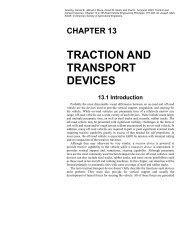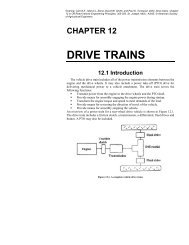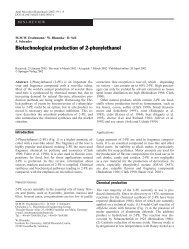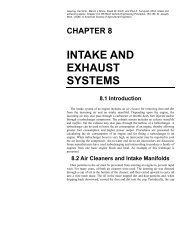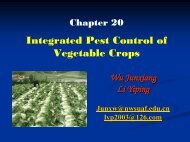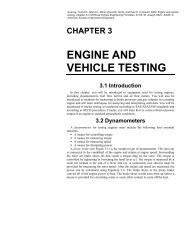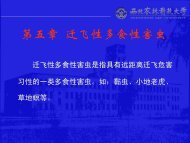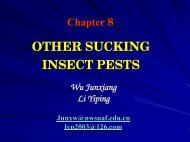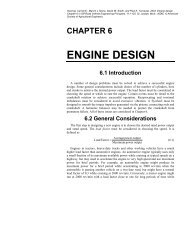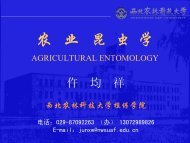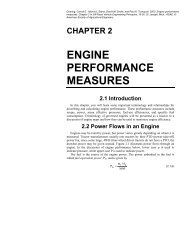You also want an ePaper? Increase the reach of your titles
YUMPU automatically turns print PDFs into web optimized ePapers that Google loves.
Chapter 10<br />
<strong>Foliage</strong> <strong>Feeders</strong><br />
Wu Junxiang<br />
Li Yiping<br />
Junxw@nwsuaf.edu.cn<br />
lyp2003@126.com
Chapter 10 <strong>Foliage</strong> <strong>Feeders</strong><br />
Lecture Outline<br />
Cabbage abbage white butterflies<br />
Diamondback moth<br />
<strong>Foliage</strong>-feeding<br />
<strong>Foliage</strong> feeding noctuids<br />
<strong>Foliage</strong>-feeding <strong>Foliage</strong> feeding caterpillars<br />
Cochlids<br />
Other foliage-feeding foliage feeding moths<br />
<strong>Foliage</strong>-feeding <strong>Foliage</strong> chrysomelid beetles<br />
Other foliage-feeding foliage feeding pests<br />
Control techniques
Ⅰ.Cabbage Cabbage white butterflies<br />
(菜粉蝶 菜粉蝶) )<br />
菜粉蝶Cabbage 菜粉蝶 Cabbage white butterfly =<br />
white butterfly; 幼虫称为菜青虫<br />
Lepidoptera, Pieridae.<br />
Pieridae
Small white butterfly Pieris rapae<br />
Large white butterfly P. brassicae<br />
Indian cabbage white butterfly P. canidia (东方 东方<br />
粉蝶) 粉蝶<br />
1. Common Species<br />
P. melete (褐脉粉蝶 褐脉粉蝶)<br />
Bath white butterfly Pontia daplidice (云斑粉蝶 云斑粉蝶) )
Small white butterfly Pieris rapae (菜粉蝶 菜粉蝶)
Small white butterfly Pieris rapae (菜粉蝶 菜粉蝶)
Small white butterfly Pieris rapae (菜粉蝶 菜粉蝶)
Large white butterfly P. brassicae (大菜粉蝶 大菜粉蝶)
Indian cabbage white butterfly P. canidia (东方粉蝶 东方粉蝶)
Bath white butterfly Pontia daplidice (云斑粉蝶 云斑粉蝶)
翅的脉纹和<br />
斑点暗褐色<br />
P. melete (褐脉粉蝶 褐脉粉蝶)
2. Distribution<br />
Small white butterfly: generally worldwide,<br />
nationwide in China.<br />
Large white butterfly: Xinjiang, Sichuan, Yunnan<br />
and South of Xizang; causes severe damage in<br />
Xinjiang.<br />
Bath white butterfly (斑粉蝶 ( 斑粉蝶): ): lightly in Northern<br />
China.<br />
P. melete (褐脉粉蝶 褐脉粉蝶): ): very lightly in northern,<br />
central and eastern China.<br />
Indian cabbage white butterfly (东方粉蝶 ( 东方粉蝶): ): very<br />
lightly in southern China.
3. Damage<br />
Oligophagy. Mainly feed on crucifer vegetables,<br />
especially prefer cabbage (甘蓝 甘蓝) ) and cauliflower<br />
(花椰菜 花椰菜). ).<br />
Generally, Generally, the first and second larval instars feed<br />
on the outer, older leaves. The final three stages<br />
move into the central plant portion, commencing<br />
feeding at the leaf margin and continuing towards<br />
the central leaf vein. After a bad attack only the<br />
main veins remain.
3. Life Cycle of Small white butterfly<br />
4-5 5 generations/year in northeast, Huabei<br />
and eastern northwest China; 5-8 5 8 in mid-<br />
downstream of Yangtse River; 8-9 8 9 in<br />
Changsha.<br />
Overwinter as pupae in all kinds of refuges<br />
near vegetable orchards, such as on fences,<br />
plant trunks and in soil gaps and weeds.
3. Life Cycle of Small white butterfly<br />
Causes severe damage in spring (April to June) and<br />
autumn (Sep. to Oct.) in most parts of China. Or July to<br />
Aug. in colder areas, especially higher altitudes.<br />
Overwintered pupae come to eclosion in March in mid-<br />
downstream of Yellow River. Newly hatched larvae<br />
appear in April. Damage peaks from May to June.<br />
Population decreases from Jul. to Aug. It increases again<br />
in Sep. Then the second damage peak appears, which is<br />
less severe than the first.
3.<br />
Adult Behavior of Small white butterfly<br />
Adults active during daytime.<br />
Favor sucking nectar.<br />
Attracted by mustard oil (芥子油 芥子油) ) spread by<br />
cruciferous plants in fields.<br />
Deposit eggs individually on leaves; mostly on<br />
backsides in summer and mostly on faces in<br />
winter. Each female lays about 300-400 300 400 eggs.
3. Characteristics of Small white butterfly<br />
Larvae have 5 instars.<br />
Larval stage causes plant damage, but only<br />
to the portion above ground.<br />
Grown larvae often crawl a long distance<br />
to find a place to pupate.
3. Factors influencing population<br />
Climate conditions;<br />
Host plants;<br />
Natural enemies.
Ⅱ. . Diamondback moth<br />
Diamondback moth Plutella xylostella (L.)<br />
(Chinese byname: 小菜蛾, 方块蛾)<br />
Lepidoptera, Plutellidae
Diamondback moth Plutella xylostella
Diamondback moth Plutella xylostella
1. Distribution and Damage<br />
Cosmopolitan species.<br />
Nationwide pest in China, especially in<br />
South. One of the most destructive crucifer<br />
pests in the mid-downstream mid downstream of Yangtse<br />
River since the 1970’s. 1970 s. It has become more<br />
and more severe in northern China<br />
since the 1990’s. 1990 s.
1. Distribution and Damage<br />
Polyphagous pest. Mainly damage crucifer<br />
vegetables. Also damage tomato, potato, ginger (姜), ( ),<br />
onion (洋葱 ( 洋葱). ).<br />
1st instar feeds on the spongy tissue forming<br />
shallow mines beneath the leaf surface. All the leaf<br />
tissues are consumed except the veins. On some<br />
leaves, the larvae feed on all but the upper<br />
epidermis creating a “windowing” effect (天窗). In<br />
their last stage, larvae are voracious feeders; they<br />
cause more damage than the first three larval<br />
instars.
2. Life Cycle and Behavior<br />
4-5 5 generations/year in North; overwinter<br />
as pupa under old plant remnants. 9-14 14<br />
generations/year in valley of Yangtse River,<br />
17 in Guangxi. Continuous reproduction<br />
occurs in the southern parts of China.
2. Life Cycle<br />
In northern China, overwintered pupae<br />
begin to become moths as seedlings come up.<br />
Except for the 1st and 2nd , many generations<br />
overlap throughout the year. . They cause<br />
severe damage from May to June and Aug. to<br />
Sep., and even more severe damage from May<br />
to Jun.<br />
In Xinjiang, the most severe damage occurs<br />
from Jul. to Aug.<br />
In southern China, two damage peaks occur.
3. Behavior<br />
Diamondback moths are nocturnal fliers,<br />
inactive during the day. If disturbed during the<br />
day, they fly erratically.<br />
Mating begins on the day of emergence at dusk.<br />
Egg laying begins shortly after dusk and peaks<br />
about two hours later. Few eggs are laid after<br />
midnight.
3. Behavior<br />
Egg number laid per female may range from 18<br />
to 356; mean being 159. Ovipositing normally<br />
begins on the day of emergence, lasting about 10<br />
days. The peak occurs on the first night of the<br />
ovipositing.<br />
Newly hatched larvae crawl to the under-surface<br />
under surface<br />
of the leaf and may shallowly bore into the leaf and<br />
feed on the tissue beneath the leaf surface. The<br />
remaining three larval stages feed on the surface,<br />
consuming all the leaf tissue except the veins and
3. Behavior<br />
Larvae wriggle backwards rapidly when<br />
disturbed. They may also drop from the leaf,<br />
suspended by a silken thread, to remain suspended<br />
temporarily, or drop to a lower leaf.<br />
Larvae are susceptible to drowning; the first<br />
instars are the most vulnerable. An average<br />
mortality rate of 56% caused by rainfall has been<br />
reported.
Ⅲ. . <strong>Foliage</strong>-feeding<br />
<strong>Foliage</strong> feeding Noctuids<br />
(食叶夜蛾类<br />
食叶夜蛾类)<br />
Lepidoptera<br />
Noctuidae
1. Common Species<br />
Oriental armyworm Mythimna separata<br />
Beet armyworm Spodoptera exigua<br />
Cotton leafworm, tobacco cutworm<br />
Prodenia litura (斜纹夜蛾)<br />
Cabbage army moth, cabbage moth<br />
Mamestra brassicae (甘蓝夜蛾)<br />
Argyrogramma agnata (银纹夜蛾)
Oriental armyworm<br />
Mythimna separata
Beet armyworm Spodoptera exigua
Cotton leafworm<br />
Tobacco cutworm<br />
Prodenia litura<br />
(斜纹夜蛾 斜纹夜蛾)
Cabbage army moth, cabbage moth<br />
Mamestra brassicae (甘蓝夜蛾 甘蓝夜蛾)
前翅有马蹄形和半圆形<br />
银色斑纹各1个<br />
Argyrogramma agnata (银纹夜蛾 银纹夜蛾)
前翅有1大的“V”字形银色斑纹<br />
前翅有1大的 字形银色斑纹
1. Distribution and Damage<br />
Cosmopolitan pests; Nationwide in China;<br />
Polyphagous pests.<br />
Beet armyworm: 138 plants in 35 families;<br />
Cotton leafworm: leafworm:<br />
290 sp. in 99 families;<br />
Cabbage moth: 120 sp. in 30 families<br />
Voracious Voracious<br />
Damage varies greatly.
1. Distribution and Damage<br />
Young larvae feed in terminal clusters<br />
of host crops and often do considerable<br />
damage before they are noticed. Leaves may<br />
be skeletonized and almost completely<br />
consumed. Plant stems are seldom eaten<br />
clear through as in several cutworm cases.<br />
Young seedlings can be completely<br />
destroyed.
2. Life Cycle and Behavior<br />
1. Beet armyworm Spodoptera exigua<br />
4-5 5 generations/year in mid-downstream mid downstream valley<br />
of Yellow River; overwinter as pupae in soil cells;<br />
cause the most damage from Jul. to Aug.<br />
No dipause. dipause.<br />
Occur and reproduce all over the<br />
year in tropic and sub-tropic sub tropic areas such as<br />
Guangdong.
2. Life Cycle and Behavior<br />
1. Beet armyworm Spodoptera exigua<br />
Faints, curling and falling to the ground<br />
when disturbed<br />
Cannibalism (dog-eat (dog eat-dog) dog)<br />
Move aggregately.<br />
Grown larvae pupate in soil cells.<br />
favor higher temperatures and fear lower.
Beet armyworm<br />
Spodoptera exigua
2. Life Cycle and Behavior<br />
2. Cabbage moth Mamestra brassicae<br />
2-3 3 generations/year in North of China;<br />
overwinter as diapause pupae in soil cells;<br />
most damage done to cabbage (甘蓝 ( 甘蓝) ) and<br />
Chinese cabbage (白菜 ( 白菜) ) from late Aug. to<br />
early Oct.
2. Life Cycle and Behavior<br />
3. Cotton<br />
3. Cotton leafworm Prodenia litura (斜纹夜蛾 斜纹夜蛾)<br />
Migratory insect, no diapause in winter;<br />
3-4 4 generations/year in northern parts, 4- 4<br />
5 in mid-stream mid stream of Yellow River, 5-6 5 6 in<br />
valley of Yangtse River, 6-9 6 9 in South;<br />
No overwintering individuals found in<br />
North;<br />
Most severe damage from Jul. to Oct.<br />
everywhere.
Management Tactics<br />
The characteristics of the beet armyworm,<br />
Cotton leafworm (斜纹夜蛾 斜纹夜蛾) ) and Cabbage army<br />
moth (甘蓝夜蛾 ( 甘蓝夜蛾) ) are such that they have occasional<br />
and unpredictable population outbreaks. Integrated<br />
pest management should be carried out based on the<br />
following tactics: forecasting well in advance,<br />
immediately spraying insecticides when necessary,<br />
and, at the same time, trapping and killing adults,<br />
extirpating the egg masses and cutting weeds in order<br />
to decrease pests.<br />
根据甜菜夜蛾、甘蓝夜和斜纹夜蛾偶发、突发成灾的特点,防治工作应在搞好测报的<br />
前提下,及时实施药剂防治,并辅以诱杀成虫、摘除卵块、铲除杂草减少虫源等防治措<br />
施,综合治理。<br />
2. Management
2. Management<br />
Control measures<br />
1) Cultural Control<br />
Destroy weeds;<br />
Decrease overwintering pupae by digging<br />
and plowing soil in autumn and winter<br />
2) Trap-killing Trap killing adults<br />
Trap-killing Trap killing by light, sugar-vinegar<br />
sugar vinegar-<br />
alcohol mixture
2. Management<br />
Control measures<br />
3) Collect eggs and catch larvae manually<br />
Egg masses;<br />
Newly hatched larvae feed together,<br />
mostly on the underside of the leaves;<br />
4) Chemical control<br />
Spray insecticides before 3 rd instar larvae
Ⅳ. . Other Common Noctuid Pests<br />
大造桥虫
Other Common Noctuid Pests<br />
小造桥虫
Other Common Noctuid Pests<br />
桃剑纹夜蛾
Other Common Noctuid Pests<br />
桃剑纹夜蛾
Ⅴ. . <strong>Foliage</strong>-feeding <strong>Foliage</strong> feeding Caterpillars<br />
(食叶毛虫类<br />
食叶毛虫类)<br />
Arctidae, Arctidae,<br />
Lymantriidae,<br />
Lymantriidae,<br />
Pieridae and<br />
Lasiocampidae (枯叶蛾科 枯叶蛾科) ) in Lepidoptera,
1. Common Species<br />
Phalera flavescens (舟形毛虫 舟形毛虫, , 苹掌舟蛾) 苹掌舟蛾<br />
Porthesia similes (金毛虫 金毛虫, , 黄尾毒蛾) 黄尾毒蛾<br />
Gypsy moth Lymantria dispar (舞毒蛾 舞毒蛾) )<br />
Amsacta lactinea (红缘灯蛾 红缘灯蛾) )<br />
Fall webworm Hyphantria cunea (美国白蛾 美国白蛾) )<br />
Malacosoma neustria testacea (天幕毛虫 天幕毛虫)<br />
Aporia crataegi (山楂粉蝶 山楂粉蝶) )
Amsacta lactinea<br />
(红缘灯蛾 红缘灯蛾)
Porthesia similes (金毛虫 金毛虫, , 黄尾毒蛾)<br />
黄尾毒蛾
Phalera flavescens (舟形毛虫 舟形毛虫,苹掌舟蛾 苹掌舟蛾)
Phalera flavescens (舟形毛虫 舟形毛虫, , 苹掌舟蛾)<br />
苹掌舟蛾
卵块<br />
♂<br />
Gypsy moth Lymantria dispar (舞毒蛾 舞毒蛾)<br />
♀
♂<br />
♀<br />
Orgyia gonostigma<br />
(角斑古毒蛾<br />
角斑古毒蛾)
Fall webworm<br />
Hyphantria cunea<br />
(美国白蛾 美国白蛾)
Fall webworm<br />
Hyphantria cunea<br />
(美国白蛾 美国白蛾)
Odonestis pruni<br />
苹果枯叶蛾<br />
老熟幼虫
Phalera flavescens (舟形毛虫 舟形毛虫, , 苹掌舟蛾)<br />
苹掌舟蛾<br />
1 generation/year.<br />
Overwinter as pupae in soil under tree<br />
crown.<br />
Adults emerge from early Jul. to early<br />
Aug.<br />
Strong phototaxis. phototaxis<br />
Eggs in mass laid underside of leaves.<br />
Newly hatched larvae feed on foliage;<br />
later spread to feed.
Phalera flavescens (舟形毛虫 舟形毛虫, , 苹掌舟蛾)<br />
苹掌舟蛾<br />
Spin silk to drop when disturbed; Both<br />
head and end turn up when at rest.<br />
Larvae become grown from late Aug. to<br />
mid Sep. and pupate in soil to overwinter. overwinter<br />
Control keys include digging soil under tree<br />
crown; destroying leaves with larvae and<br />
spraying insecticides in initial larval stage.
Ⅵ. . COCHLIDS (刺蛾类 ( 刺蛾类)<br />
Cochlid (刺蛾 刺蛾) )<br />
larvae called as 洋辣<br />
子, , 八角虫; 八角虫<br />
Lepidoptera;<br />
Eucleidae (刺蛾科 刺蛾科)
1. Common Species<br />
Oriental moth Cnidocampa flavescens (黄刺 黄刺<br />
蛾)<br />
Thosea sinensis (扁刺蛾 扁刺蛾)<br />
Latoia sinica (中国绿刺蛾<br />
中国绿刺蛾) )<br />
Latoia consocia (褐边绿刺蛾<br />
褐边绿刺蛾) )<br />
Latoia hilarata (双齿绿刺蛾<br />
双齿绿刺蛾) )
Oriental moth Cnidocampa flavescens (黄刺蛾 黄刺蛾)
Latoia consocia<br />
褐缘绿刺蛾
外横线暗褐色, ♂中室<br />
上角有一黑点<br />
Thosea sinensis (扁刺蛾 扁刺蛾) )
成虫前翅外缘褐色宽<br />
带内缘在中部及臀角<br />
处各有一齿形曲<br />
Latoia hilarata<br />
双齿绿刺蛾
Parasa sinica<br />
(中国绿刺蛾<br />
中国绿刺蛾, , 棕边青刺蛾)<br />
棕边青刺蛾
2. Damage<br />
Polyphagous pests. Host plants include apple,<br />
pear, peach and more than 120 other trees;<br />
Larvae feed on leaves and produce notches and<br />
holes on the leaves. When the population is high,<br />
eating all the leaves off the trees and leaving only the<br />
branches. This situation often occurs in wild<br />
orchards. Larvae are slug-like and hairy and cause<br />
great pain and irritation to humans when they make<br />
contact with their skin. Larvae make bird’s egg<br />
shaped cocoons when they are mature.
Cnidocampa flavescens<br />
黄刺蛾<br />
1 generation/year;<br />
Overwinter as grown larvae in cocoon on<br />
tree branches;<br />
Adults appear in June;<br />
Eggs in masses laid underside of leaves;<br />
decade of eggs in a mass;<br />
Larvae occur from mid Jul. to late Aug.<br />
Young larvae group together to feed, later<br />
spread.



